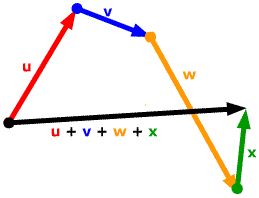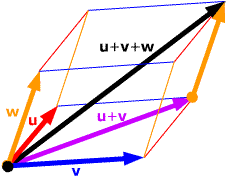 The
first rule: vector addition is commutative:
for any vectors u and v,
The
first rule: vector addition is commutative:
for any vectors u and v, u + v = v + u.
It's easy to see why; look at the parallelogram rule for addition. No matter which order we choose u and v in, their sum is just the diagonal of the parallelogram they form.
 What
if we want to add three or more vectors? The triangle rule (head-to-tail
rule) suggests that we line them all up head to tail; then take as the sum
the vector with the tail of the first vector and the head of the last.
What
if we want to add three or more vectors? The triangle rule (head-to-tail
rule) suggests that we line them all up head to tail; then take as the sum
the vector with the tail of the first vector and the head of the last. The diagram shows the result of both sides of this calculation: the black vector.
You can change the vectors by dragging their heads.
The vectors in the diagram need not all lie in the same plane; all our calculation rules work for vectors in 2-space or in 3-space.
(u + v)+ w = u + (v + w)
A parallelepiped is a three-dimensional solid with all of its faces parallelograms. Suppose we have three vectors which don't all lie in a plane. Place them all tail-to-tail and make them into the edges of a parallelepiped, as in the diagram.
 If
we use the parallelogram rule to find u + v and
then the triangle rule to find (u + v)+ w,
we get a vector from one corner of the parallelepiped to the opposite corner.
We could have started with any other pair of vectors; the result will still
be the same vector between the two opposite corners.
If
we use the parallelogram rule to find u + v and
then the triangle rule to find (u + v)+ w,
we get a vector from one corner of the parallelepiped to the opposite corner.
We could have started with any other pair of vectors; the result will still
be the same vector between the two opposite corners.
In other words, the sum of three vectors not all in a plane is the diagonal of the parallelepiped they form.
If c and d are positive, this is easy to see: the result in all three calculations is just a vector with length cd times the length of v and the same direction as v. If either or both of c and d are negative, we have to take direction reversals into account, but there are always the same number of reversals in each part of the calculation, so the rule still works.
 If
we have the sum of scalars times a vector, we have the rule: scalar
multiplication is distributive over the sum of scalars. Symbolically,
for any scalars c and d and any vector v,
If
we have the sum of scalars times a vector, we have the rule: scalar
multiplication is distributive over the sum of scalars. Symbolically,
for any scalars c and d and any vector v, (c + d)v = cv + dv.
If c and d are positive (as in the diagram), this is easy to see visually: the result for both sides of the calculation is a vector with length c + d times the length of v and the same direction as v.
If either or both of c and d are negative, the same basic idea still works, but some of the vectors have the opposite direction, which needs to be accounted for.
In the diagram, you can change the value of the scalar c with the slider, and you can change the vectors u and v (the darker red and blue ones) by dragging their heads.
c(u + v) = cu + cv.
 Geometric
Vectors Geometric
Vectors |
||||
| Introduction | Representing geometric vectors | Adding geometric vectors | Multiplying geometric vectors by scalars | Calculation rules for addition and scalar multiplication |